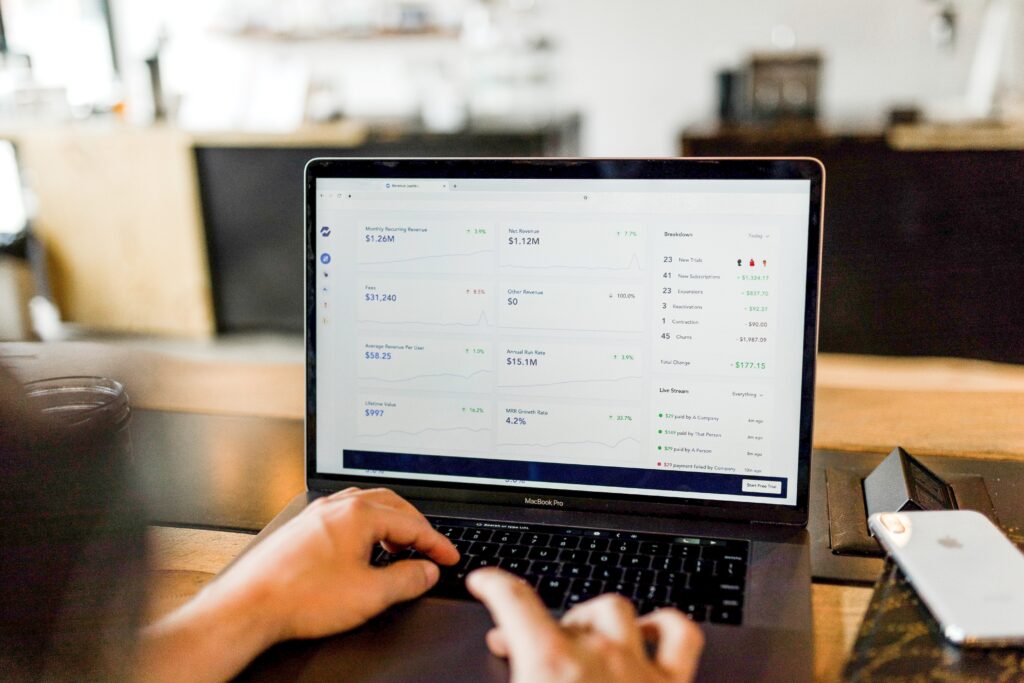Improving investment decisions with software as a service

In today’s fast-paced business environment, making informed investment decisions is crucial for the success of any organization. That’s where software as a service (SaaS) comes into play. SaaS platforms provide businesses with the tools and capabilities to optimize their investment strategies, streamline operations, and drive growth. From investment analysis and portfolio management to market research and customer acquisition, SaaS solutions offer a wide range of functionalities to help businesses make better and more profitable investment decisions. By leveraging the power of SaaS, organizations can gain a competitive edge, improve efficiency, and maximize returns on their investments.

Introduction to Software as a Service (SaaS)
Software as a Service (SaaS) has revolutionized the way businesses operate and make decisions. In this article, we will explore the definition and overview of SaaS applications, the benefits of using SaaS for investment decisions, the various types of SaaS applications available for investment decisions, the key features to look for in investment-focused SaaS, real-life case studies demonstrating the transformational power of SaaS in the investment field, as well as the challenges and considerations associated with adopting investment-focused SaaS. We will also provide insights into the process of implementing SaaS for enhanced investment decisions and discuss future trends and developments in investment-focused SaaS. By the end of this article, you will have a comprehensive understanding of how SaaS can revolutionize your investment strategies and empower your decision-making process.
Definition of SaaS
Software as a Service (SaaS) refers to a cloud-based software delivery model in which software applications are accessed and used over the internet on a subscription basis. Unlike traditional software deployment models where software is installed locally on individual computers or on-premises servers, SaaS applications are hosted and managed by a third-party provider. This allows users to access the software through a web browser or a dedicated application, eliminating the need for complex installations and enabling easy scalability, flexibility, and accessibility.

Overview of SaaS Applications
SaaS applications encompass a wide range of software solutions designed to meet the specific needs of businesses across various industries. These applications are hosted on the provider’s servers and can be accessed from anywhere with an internet connection. SaaS applications are typically designed to be user-friendly, with intuitive interfaces and streamlined workflows. Some common examples of SaaS applications include customer relationship management (CRM) software, project management software, accounting software, and human resources management software.
Benefits of SaaS for Investment Decisions
Improved accessibility and mobility
One of the major advantages of using SaaS for investment decisions is the enhanced accessibility and mobility it offers. Since SaaS applications are accessed through the internet, you can access your investment data and make informed decisions from any device with an internet connection. This means that you can analyze market trends, track portfolio performance, and collaborate with team members or clients on the go, without being restricted to a specific location or device.
Reduced upfront costs
Investment-focused SaaS applications are typically offered on a subscription basis, which means you pay a recurring fee to access and use the software. This subscription-based model eliminates the need for upfront capital investments in hardware and software licenses, making it a cost-effective option for businesses, especially small and medium-sized enterprises (SMEs). Additionally, SaaS providers handle the maintenance, updates, and security of the software, further reducing your IT infrastructure costs and allowing you to focus on your core investment activities.
Scalability and flexibility
SaaS applications are designed to be highly scalable and flexible, allowing you to easily adapt to changing investment needs and scale your operations up or down as required. With SaaS, you can quickly add or remove users, upgrade or downgrade your subscription plan, and integrate additional modules or functionalities as your business grows. This scalability and flexibility enable you to stay agile in a dynamic investment landscape and optimize your resources effectively.
Enhanced security and data protection
Data security and protection are critical considerations for investment decisions. SaaS providers invest heavily in robust security measures and infrastructure to ensure the confidentiality, integrity, and availability of your investment data. They employ encryption techniques, access controls, and regular audits to safeguard your sensitive information from unauthorized access, data breaches, and other security threats. By leveraging SaaS applications, you can have peace of mind knowing that your investment data is protected by industry-standard security protocols and practices.
Streamlined collaboration and communication
Investment decisions often involve collaboration and communication among team members, clients, and external stakeholders. SaaS applications facilitate streamlined collaboration by providing centralized platforms where users can share, access, and collaborate on investment-related documents, reports, and data. These platforms often include features such as real-time document editing, commenting, and version control, ensuring seamless collaboration and efficient communication among team members regardless of their physical locations.

Types of SaaS Applications for Investment Decisions
Portfolio management software
Portfolio management software is designed to help investors and asset managers efficiently track, analyze, and manage investment portfolios. These applications provide comprehensive features such as portfolio tracking, performance measurement, risk analysis, asset allocation, and reporting. They often integrate with market data providers and financial institutions to provide real-time pricing and market data, enabling you to make informed investment decisions and optimize your portfolio performance.
Risk assessment and management tools
Risk assessment and management tools are essential for investors seeking to evaluate and mitigate potential risks associated with their investment decisions. These tools provide risk analysis, scenario modeling, and stress testing functionalities, allowing you to assess the risk-reward tradeoff and make informed decisions. They often incorporate historical data, statistical models, and quantitative analysis techniques to provide insights into the potential risks and their impact on your investment portfolio.
Financial analysis and reporting software
Financial analysis and reporting software is designed to help investors analyze and interpret financial data, generate financial reports, and gain insights into the financial health and performance of companies or investment opportunities. These applications often include features such as financial statement analysis, ratio analysis, cash flow forecasting, and benchmarking. They enable you to identify investment opportunities, evaluate their financial viability, and monitor the financial performance of your investments.
Market research and data analytics platforms
Market research and data analytics platforms provide investors with access to vast amounts of market data, industry trends, and economic indicators. These platforms often incorporate advanced data analytics and visualization tools, allowing you to explore, analyze, and interpret the data to identify investment opportunities and make data-driven decisions. They may also include features such as sentiment analysis, social media monitoring, and competitor analysis, providing a holistic view of the market landscape.
CRM and investor relationship management software
CRM and investor relationship management software is essential for investment professionals looking to manage and nurture relationships with clients, prospects, and partners. These applications provide functionalities such as contact management, deal pipeline tracking, email marketing automation, and client communication tracking. They enable you to streamline your client relationship management processes, enhance customer satisfaction, and improve overall operational efficiency.
Features to Look for in Investment-focused SaaS
Real-time data feeds and updates
Real-time data feeds and updates are crucial for investment decisions, as they allow you to stay up to date with the latest market trends, news, and pricing information. When evaluating investment-focused SaaS applications, look for those that provide real-time data integration and updates from reliable market data providers. This ensures that you have access to accurate, timely information to make informed investment decisions.
Customizable dashboards and reports
Customizable dashboards and reports are essential for tailoring the SaaS application to your specific investment requirements and preferences. Look for applications that allow you to create personalized dashboards and reports that display the key performance indicators (KPIs) and metrics most relevant to your investment strategy. This flexibility enables you to monitor and analyze your investments effectively and make data-driven decisions.
Integration with third-party software and APIs
Integration capabilities are crucial when selecting investment-focused SaaS applications, especially if you already have existing software systems or use external data sources. Look for applications that offer seamless integration with third-party software solutions and APIs, allowing you to consolidate your investment data and streamline your workflows. Integration with accounting software, data providers, and CRM systems can significantly enhance your investment analysis and decision-making processes.
Advanced analytics and predictive modeling
Advanced analytics and predictive modeling functionalities empower investors to leverage historical data, statistical models, and machine learning algorithms to analyze investment opportunities and predict future market trends. Look for SaaS applications that offer advanced analytics, data visualization, and predictive modeling capabilities to gain insights into potential risks and returns associated with your investment decisions. These features can significantly enhance your investment decision-making process.
Automation and workflow management capabilities
Automation and workflow management capabilities are essential for streamlining repetitive tasks, minimizing manual errors, and improving operational efficiency. Look for SaaS applications that offer automation features such as data import/export, rule-based actions, and task scheduling. These features can help you automate routine investment processes, such as data reconciliation, portfolio rebalancing, and report generation, allowing you to focus on analyzing investment opportunities and making informed decisions.
Case Studies: How SaaS Transformed Investment Decisions
Case study 1: Company X increased portfolio returns with SaaS
Company X, a leading investment management firm, implemented an investment-focused SaaS platform to streamline their portfolio management processes and enhance decision-making capabilities. By leveraging real-time data feeds, customizable dashboards, and advanced analytics, Company X was able to analyze market trends, identify investment opportunities, and optimize their portfolio allocations. As a result, they achieved a significant increase in portfolio returns and improved client satisfaction.
Case study 2: Company Y improved risk management with SaaS
Company Y, a hedge fund specializing in high-risk investments, adopted a risk assessment and management SaaS tool to evaluate and mitigate potential risks associated with their investment decisions. The software provided them with a comprehensive risk analysis framework, scenario modeling capabilities, and real-time market data integration. By leveraging these features, Company Y was able to minimize their exposure to high-risk investments, achieve better risk-adjusted returns, and enhance their overall risk management practices.
Case study 3: Company Z optimized marketing investments with SaaS
Company Z, a venture capital firm, implemented an investment-focused SaaS CRM platform to manage and nurture relationships with their investors, startups, and partners. The platform provided them with centralized contact management, deal tracking, and communication tracking capabilities. By automating their marketing efforts, analyzing investor engagement data, and leveraging personalized dashboards and reports, Company Z was able to optimize their marketing investments, improve investor satisfaction, and attract new investment opportunities.
Challenges and Considerations of Adopting Investment-focused SaaS
Data security and privacy concerns
When adopting investment-focused SaaS applications, it is crucial to ensure the security and privacy of your investment data. Evaluate the security measures implemented by the SaaS provider, such as data encryption, access controls, and data backup protocols. Additionally, consider the provider’s data privacy policies and compliance with relevant data protection regulations, such as GDPR or HIPAA. Conduct a thorough risk assessment and due diligence to ensure that your investment data is adequately protected.
Integration with existing systems and processes
Integration of investment-focused SaaS applications with your existing systems and processes can be a complex task. Evaluate the compatibility and integration capabilities of the SaaS applications with your existing software systems, data sources, and workflows. Consider the implementation timeline, data migration requirements, and any potential disruptions to your current operations. Collaborate closely with the SaaS provider and your IT team to ensure a smooth integration process.
Training and user adoption
User adoption is critical for the success of any SaaS implementation. Investing in comprehensive training programs and user onboarding initiatives is essential to ensure that your team members are comfortable using the new software and can leverage its full potential. Develop training materials, conduct workshops or webinars, and provide ongoing support and resources to encourage user adoption and maximize the benefits of your investment-focused SaaS applications.
Vendor selection and management
Choosing the right SaaS provider is a crucial decision that can significantly impact the success of your investment-focused SaaS implementation. Evaluate the reputation, experience, and financial stability of the SaaS provider. Consider factors such as their customer support, responsiveness to inquiries, and commitment to ongoing software updates and improvements. Review customer testimonials and seek recommendations from other industry professionals to ensure that you choose a reliable and reputable SaaS provider.
Costs and pricing models
Costs and pricing models can vary significantly among investment-focused SaaS providers. Consider your budget, long-term financial sustainability, and return on investment when evaluating different pricing options. Assess the scalability and flexibility of the pricing plans and consider any additional costs, such as data storage, user licenses, or customizations. Conduct a cost-benefit analysis to determine the most cost-effective solution that aligns with your investment needs and overall business strategy.
Implementing SaaS for Enhanced Investment Decisions
Assessing investment goals and requirements
Before implementing investment-focused SaaS applications, it is crucial to assess your investment goals, strategies, and operational requirements. Define the key functionalities, features, and data integrations that are essential for your investment decision-making process. Conduct a comprehensive evaluation of your investment workflows, data sources, and stakeholder requirements to identify gaps and determine the areas where SaaS applications can add the most value.
Researching and evaluating SaaS vendors
Thoroughly research and evaluate different SaaS vendors to find the one that best aligns with your investment goals and requirements. Consider factors such as the vendor’s industry experience, technical expertise, customer support capabilities, and reputation in the market. Request demos, evaluate trial versions, and engage in discussions with the vendor to ensure that their solutions meet your specific needs and can seamlessly integrate into your existing investment processes.
Planning and implementing data migration
Data migration is a critical step in implementing investment-focused SaaS applications. Develop a comprehensive data migration plan that outlines the steps, timelines, and resources required for a smooth transition. Work closely with the SaaS provider and your internal IT team to ensure that data is migrated accurately and securely. Conduct thorough testing and validation of the migrated data to ensure data integrity and completeness.
Training and onboarding users
Invest in training and onboarding initiatives to ensure that your team members are well-equipped to leverage the full potential of the investment-focused SaaS applications. Develop training materials, conduct training sessions or workshops, and provide ongoing support and resources to address any questions or challenges users may encounter. Encourage active participation and feedback from users to continuously improve the user experience and optimize the utilization of the SaaS applications.
Measuring and optimizing performance
Regularly measure and evaluate the performance of your investment-focused SaaS applications to ensure that they are delivering the desired results and meeting your investment goals. Establish key performance indicators (KPIs), such as portfolio returns, risk metrics, or operational efficiency indicators, and monitor them consistently. Conduct periodic reviews and analyze the data to identify areas for optimization or improvement. Collaborate with the SaaS provider to address any performance issues and leverage their expertise to optimize the usage of the software.
Future Trends and Developments in Investment-focused SaaS
Artificial intelligence and machine learning
Artificial intelligence (AI) and machine learning (ML) technologies are rapidly transforming the investment industry. Investment-focused SaaS applications are incorporating AI and ML algorithms to automate routine investment tasks, enhance data analysis, and provide predictive insights. These technologies enable investors to leverage large datasets, identify patterns, and make data-driven investment decisions. Continued advancements in AI and ML hold immense potential for further enhancing investment-focused SaaS applications.
Blockchain technology for secure transactions
Blockchain technology is gaining traction in the investment field due to its potential to enhance security, transparency, and efficiency in financial transactions. SaaS applications can leverage blockchain technology to enable secure and immutable recording of investment transactions, fund transfers, and ownership rights. This can streamline processes such as settlement and reconciliation, reduce transaction costs, and enhance trust among investors, asset managers, and other stakeholders.
Integration with IoT and big data analytics
The integration of investment-focused SaaS applications with the Internet of Things (IoT) and big data analytics can provide investors with access to vast amounts of real-time, granular data on various investment assets. This data can be used to perform advanced analytics, trend analysis, and predictive modeling to identify investment opportunities and optimize portfolio allocations. The combination of IoT, big data analytics, and SaaS applications holds the potential to revolutionize investment decision-making and enable data-driven investments.
Improved user experience and interface design
User experience (UX) and interface design play a crucial role in the adoption and utilization of investment-focused SaaS applications. SaaS providers are focusing on enhancing the UX and designing intuitive, user-friendly interfaces that facilitate seamless navigation, data visualization, and task execution. Improved UX and interface design enable investors to quickly access and interpret investment data, collaborate with stakeholders, and make informed decisions with ease.
Regulatory compliance and data governance
Regulatory compliance and data governance are key considerations for investment-focused SaaS applications. SaaS providers are investing in robust compliance frameworks and data governance practices to ensure adherence to industry standards and regulations such as GDPR, SEC regulations, or MiFID II. Data encryption, access controls, audit trails, and data anonymization are some of the measures implemented by SaaS providers to ensure data privacy, security, and regulatory compliance.
Conclusion
Software as a Service (SaaS) has emerged as a game-changer in the investment field, enabling investors to make informed decisions, mitigate risks, and optimize portfolio performance. By leveraging SaaS applications tailored for investment decisions, businesses can enjoy improved accessibility, reduced upfront costs, scalability, enhanced security, and streamlined collaboration. Whether it’s portfolio management software, risk assessment tools, financial analysis platforms, market research platforms, or CRM systems, investment-focused SaaS applications offer a plethora of benefits to investors.
However, embracing SaaS for investment decisions also requires careful consideration of challenges such as data security, integration with existing systems, user adoption, vendor selection, and costs. By following a systematic implementation approach, including assessing investment goals, researching SaaS vendors, planning data migration, training users, and measuring performance, businesses can maximize the value of investment-focused SaaS applications.
Looking ahead, future trends in investment-focused SaaS involve the integration of AI and ML for automation and predictive analysis, blockchain technology for secure transactions, leveraging IoT and big data analytics for data-driven investments, improving user experience and interface design, and ensuring regulatory compliance and data governance. As technology continues to evolve, investment-focused SaaS will remain a cornerstone of modern investment strategies, empowering investors with data-driven insights and facilitating better decision-making.







